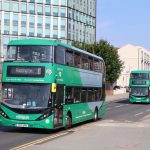In an exclusive visit to Wrightbus, the firm lifts the lid on its latest product, its fuel cell StreetDeck
There’s a tough dilemma facing bus operators running into UK cities – what technology do you buy to be future-proofed?
Euro 6c diesel is exceptionally clean, yet legislators are not convinced. Three main technologies are in the frame: Biogas, electric and hydrogen.
The merits of all three have been picked apart during the last 12 months in routeONE, in our ‘Energy on the move’ articles.

As yet, no city has mandated a specific technology, although London has set out a ‘zero-emission’ strategy. While this rules out biogas, exactly what zero-emission means is a moot point.
Wrightbus is the first to produce a genuine zero-emission battery-electric bus. Its StreetAir, debuted last year, uses electric heating, rather than the diesel-fired heating of most of its competitors.
Now it is upping its game in the hydrogen sector
Jump to the Jive
This is driven by procurement underway, led under a framework by Transport for London (TfL), sourcing up to 56 hydrogen single and double-decker buses to be used in Birmingham, Dundee, Aberdeen and London. The latter two already run hydrogen buses. Eight Wrightbus single-deckers are now in their seventh year of operation in the capital the RV1 (Covent Garden-Tower Gateway). The daily route runs 19 hours a day with a 10-12 minute frequency.
Now, Wrightbus has built an all-new pre-production StreetDeck hydrogen bus, being followed by two more currently in build.
In an exclusive visit to the firm’s Ballymena, Northern Ireland, HQ we were able to examine all three.
Technology
Invented in 1838, modern fuel cells were developed as part of space exploration. Now they are being developed for extensive use in vehicles.
Hydrogen means a bus can be fuelled, driven in its normal cycle, then at the end of the day, re-fuelled and cleaned the same as diesel buses. This ‘fuel-drive-refuel’ cycle, without the constraints of range limitations, while having a quiet and zero-emission bus is very attractive.
The stumbling block is the price. The EU’s JIVE project – like a ‘green bus fund’ for hydrogen aims to make the capital cost commercially acceptable (see panel).
In very basic terms, a fuel cell comprises an anode and a cathode, with an electrolyte that allows positively-charged hydrogen ions to move between the two sides of the fuel cell. An electro-chemical reaction of the hydrogen and air produce electricity. The exhaust is water condensate. Colourless and odourless, the vapour can only be seen on cold days.

Another benefit is that a fuel cell is compact, contains no moving parts, does not involve combustion and produces electricity for as long as fuel and air are supplied. Fuel cell life has been in excess of that predicted – as London’s in service trials prove – with the expectation that at least 25,000 hours (roughly eight years) life is easily achievable.
Clever stuff
Wrightbus is one of a number of bidders in the JIVE programme. As procurement is underway with bids not yet revealed we can’t share all details, but we were able to have a close look at the first fuel cell StreetDeck and two further under-construction in the firm’s bespoke alternative technology workshop at Ballymena.
One of these will be a two-door London-spec ‘decker. Specification of the third example, currently at the chassis framing stage, is yet to be revealed. All use Wright’s standard StreetDeck chassis.
With its long history of innovation, Wrightbus has plenty of experience. As this is a commercial project, it is using tried and tested components from respected suppliers in the build.
A fuel cell is most efficient (and long-lived) when generating electricity at a constant rate. Therefore batteries are used to store energy, from the fuel cell, or regenerative braking. To maximise engine bay and internal space, ZF’s AVE 130EV portal axle with electric hub motors are used, rather than a traction motor/drivetrain.
The batteries are the same as those used in Wright’s hybrid buses – this is a hydrogen electric hybrid. In the pre-production bus they are under the rear seats, ahead of the rear axle. Although these high back seats look unusual, the sharp eyed will spot that they are from the New Routemaster. The second bus has conventional seats on a second set of dummy wheelboxes, containing the batteries. The batteries are accessed from outside.

For evaluation, one bus uses a Ballard fuel cell; the other is from an undisclosed manufacturer.
New design
And here is a significant difference to the RV1 buses – the size of the fuel cell. With a 60kW constant output, it’s roughly half the size of that used in the RV1 buses.
This is achieved thanks to the batteries, along with the use of ‘smart accessories' taken from Wright’s Micro Hybrid range.
With a smaller fuel cell and hub motors packaging is clever. Under the bonnet the fuel cell – a rectangular box – sits in the engine bay, while Grayson smart fans are on the offside. These cool the fuel cell and hub motors; in winter the water-based system heats the bus, topped up by electric heating.
The use of smaller gas tanks means these are also in the engine bay (no high temperatures here) while refuelling – taking under 10 minutes – is at the rear offside.
Naturally, there’s a remote cloud-based diagnostic system, while the hydrogen system is fail safe – it will shut down if there’s a fault, but the bus can be driven up to 30 miles on battery power, meaning it won’t be stranded.
Test driven
With the use of standard components there’s nothing to worry operators. Wrightbus has drawn on its hybrid experience to ensure that, from a driver’s perspective, you can’t tell it’s a hydrogen bus.
The only clue is a dashboard indicator confirming that the hydrogen system is functioning correctly on start-up.
At 10.8m the length is not an issue and on our short test drive, kindly organised by William Wright, we found that as promised, the driving experience is identical to a Wrightbus hybrid.
Without a diesel engine, at rest there’s no noise apart from a very faint electrical hum, and certainly no vibration.
The driver’s cab is the same as a normal Wright’s decker – well laid out and comfortable – while the only noise that’s detectable (if you listen carefully) is from the electric steering.
Underway, power comes quickly thanks to the electric drive’s torque. Acceleration is swift and the throttle responsive to input.
In the saloon, the design of ZF’s hub motors means that unlike some others, they are very quiet.
Braking uses regeneration, and if you pay close attention, you can just about feel the foundation brakes coming into play at low speed.
When stuck in slow moving traffic, the bus happily creeps forward and is easy to drive.
In short, the driver and passenger experience are on a par with the best, as you’d expect from Wright’s.

routone Comment
Wrightbus firmly believes in hydrogen as one of the fuels of the future. Its bus uses well-proven components, and it has the experience of running its previous version in the demanding London environment.
It is savvy enough to realise that no one-size fits all, which is why alongside its super-efficient diesel (with smart accessories, it calls it Micro-Hybrid), it also offers hybrid electric, plug-in hybrid electric, pure electric, as well as hydrogen.
All of these products continue to be developed, and its latest hydrogen bus is a very strong offering.
This is good news as hydrogen offers a high daily range (similar to diesel), no need for new street or depot charging and operational flexibility.
Ultimately, the aim is for fuel cell buses to push costs to a commercial level, close to hybrids, and with Wrightbus’ long experience in electric drivetrains and innovation, it is well placed to meet this challenge.Find out more: www.fch.europa.eu and here
IN SHORT
JIVE: EU’s hydrogen fund
To help commercialise fuel cell buses, the EU’s Joint Initiative for hydrogen Vehicles across Europe (JIVE) project is funding €32m to deploy at least 139 buses, in a six-year project in nine cities.
JIVE2, under development, will add another 125 buses.
A previous EU fund delivered 56 buses from six OEMs in 10 cities. By 2020 there will be around 400 hydrogen buses in service.

























